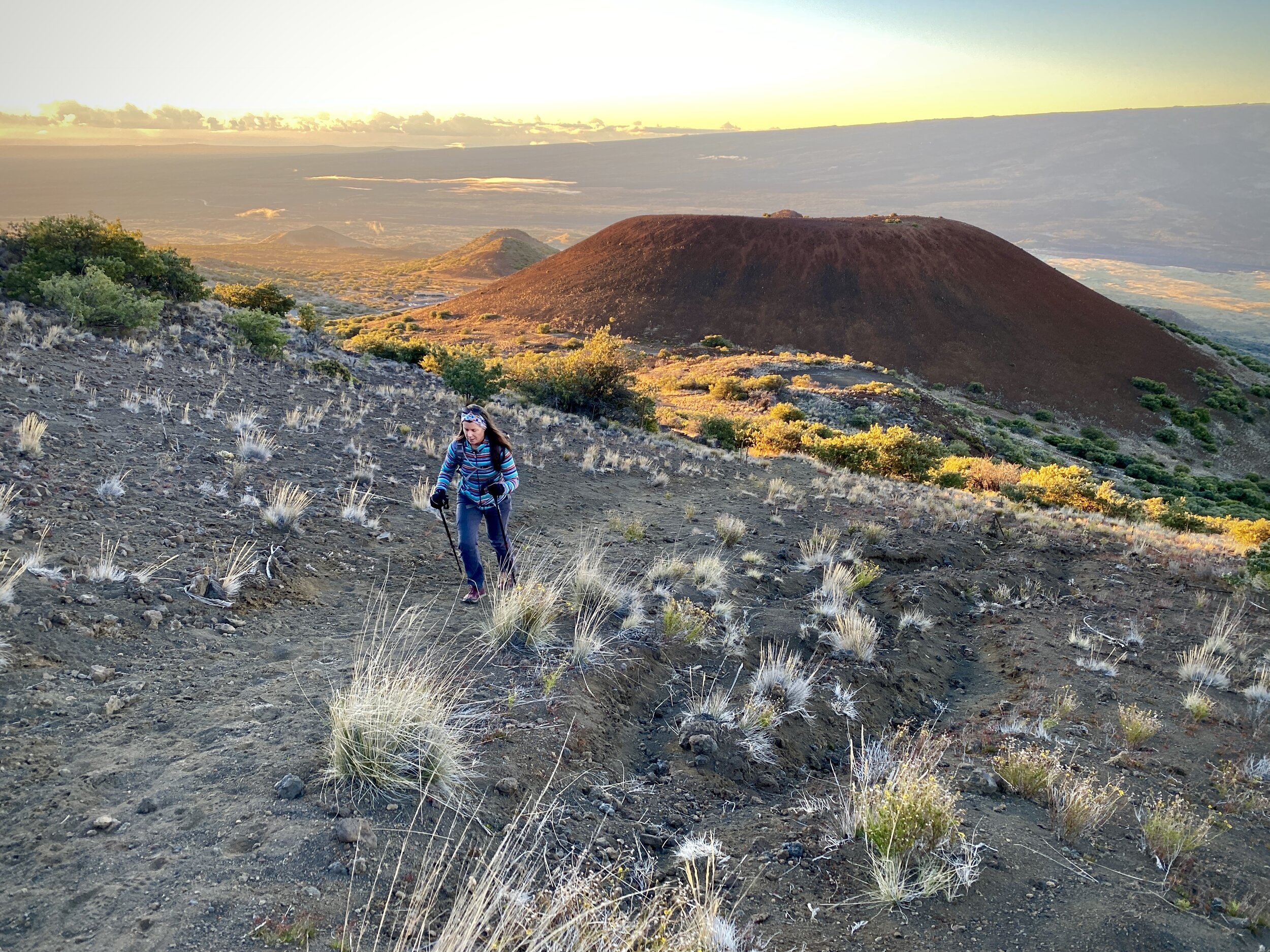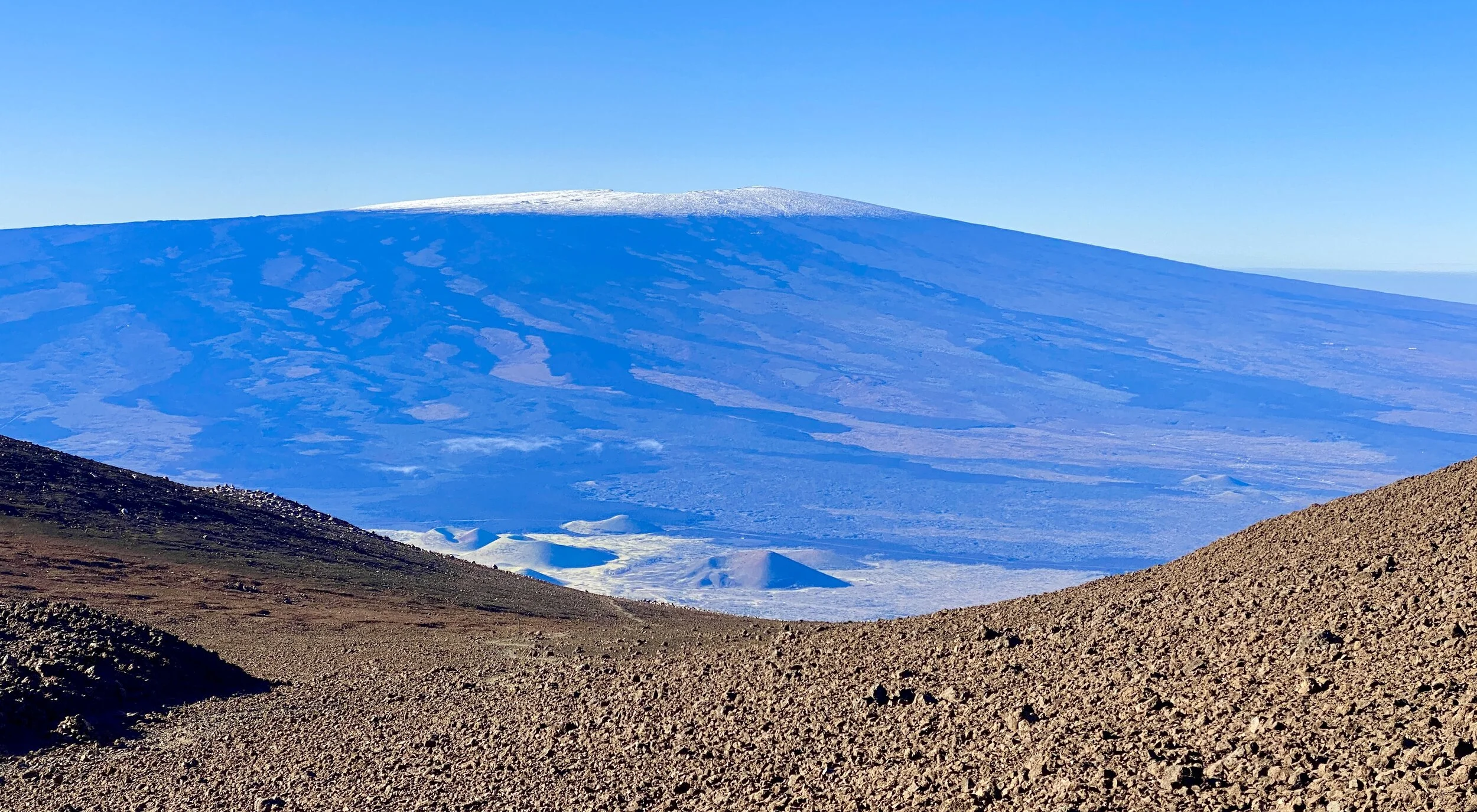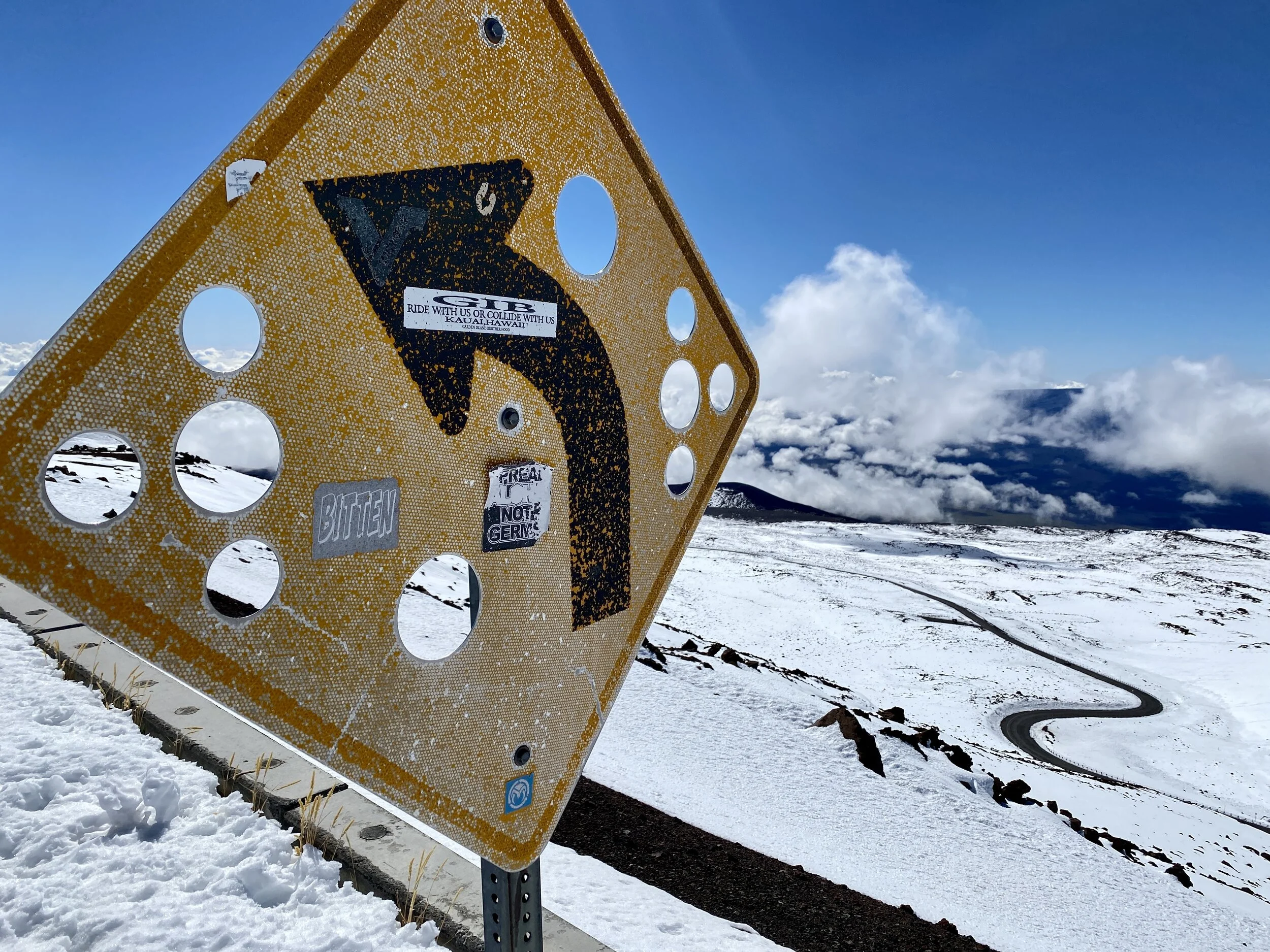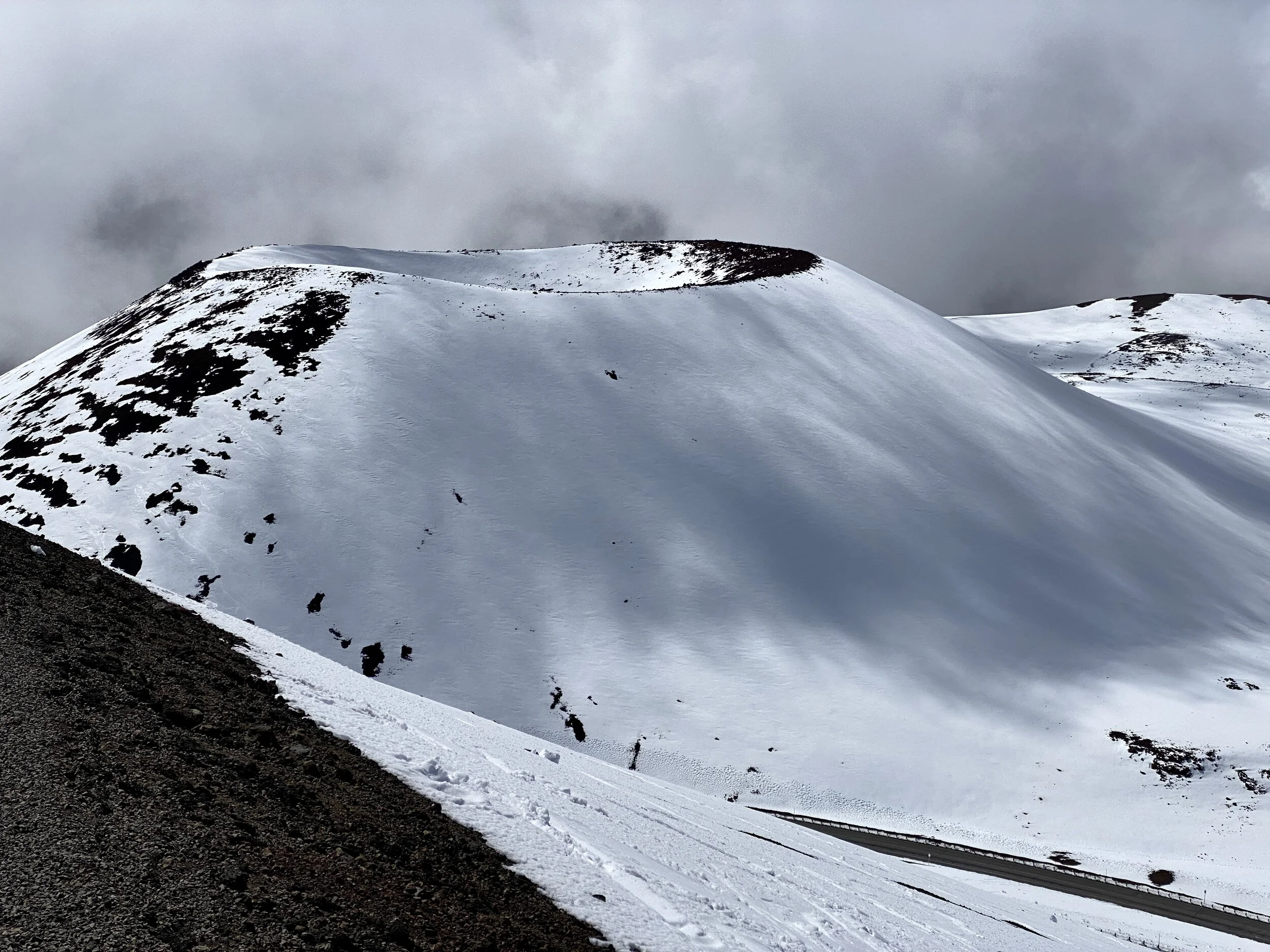Climb the highest mountain in Hawaii
Called Mauna Kea, Hawaii’s highest mountain is a dormant shield volcano that stands 13,796 feet above the Pacific Ocean on The Big Island. Climbing Mauna Kea doesn’t take technical skill, but it’s a strenuous effort, even for well conditioned hikers.
A road snakes its way to the summit, but it’s not uncommon for it to close due to snow, ice and wind, particularly during winter.
Climbers attempting this sky-scraping volcano must be prepared for rapidly shifting weather and have good shoes, properly-layered clothing and ample food and water.
The Mauna Kea climbing route
The trek to the top of Hawaii’s highest volcano starts at 9,200 feet at the Maunakea Visitor Information Station (VIS) and climbs 4,670 feet over 6.5 miles, making for a lung-burning 13-mile round trip that’s certain to leave you with sore feet and aching legs. The Mauna Kea-Humu'ula Trail is well signed, super obvious or both, so while the effort will wipe you out, you’re unlikely to get lost.
We left our rental house on Kealakekua Bay before dawn and arrived at the VIS as the sky started glowing twilight orange. We slipped into long underwear and winter hats in the parking lot, donned packs and aimed uphill.
From the VIS parking lot you hike about a quarter mile up the paved road before turning left (west) and climb a wide, well-worn trail to a ridge with sweeping views to the east and west. We stopped to watch the sun rise and admired the numerous small cinder cones that speckled the valley between Mauna Kea and the neighboring volcano, Mauna Loa, before resuming the climb.
The trail follows the ridge and is quite steep for a few miles. More than once, I looked up at a towering cinder cone as we approached and wondered if we’d have to climb it. Each time the trail went around and, eventually, far higher.
Vegetation also changes rapidly with the ascent. Desert scrub gives way to spotty grasses and then no vegetation at all. Within the first 2,000 feet we realized the upper reaches of Mauna Kea are comprised entirely of lava and devoid of life. If the wind isn’t blowing, it is dead still and silent. If anything lives up there (and I’m sure it does), we didn’t see it.
Climbers encounter some of the toughest uphill hiking within the first 2,000 vertical feet, and then the grade mellows until the final summit push.
If you climb Mauna Kea in January or February, snow may be inevitable. This is Pu'uhaukea a 13,448-foot cinder cone on Mauna Kea’s shoulder. The trail goes around it to the west.
We hiked Mauna Kea between storms and encountered spotty snow at about 11,500 feet and solid snow at about 12,000 feet. Climbing in early morning, the snow was frozen and supportive and helped smooth the ankle-bending terrain. A few hours later, it had softened and made for a pleasant glissade that sped our descent. It’s easy to see, though, that if the snow is frozen microspikes will make the climb safer.
On a map it looks like the trail and summit road are on almost on top of each other, but for the most part the trail offers abundant seclusion. There’s a system of cinder cones on the south side of the volcano, and the trail goes to go to their west while the road goes to their east.
While proximity to a road takes a little of the adventure out of the climb, it’s a good safety valve if you need it. If you find yourself in trouble and in need of help, go east, and you’ll eventually find the road.
For roughly the final mile and 1,000 vertical feet, the trail rejoins the road, which makes for an anticlimactic finish to a really peaceful hike. It’s also surreal to arrive among the dozen different observatories scattered around Mauna Kea’s upper slopes. The buildings that house giant telescopes and other sophisticated universe-probing equipment stand like cathedrals to science. They’re incredibly interesting on one hand, and a blemish on an otherwise pristine summit on the other.
When the road finally tops out, you' haven’t quite made it to the summit, which is a little to the east and accessible by a short trail. It’s worth pointing out, however, that the actual summit is considered sacred to native Hawaiians, and visitors are asked not to stand directly on it. We were satisfied with the road.
Finally, while the climb to the summit made for a grueling five hour hike, the hike back down shouldn’t be taken too lightly. The return trip is long, your legs are already tired, and the day’s weather often shifts by mid-day. We had perfect blue skies for the entire climb. Spotty cumulous clouds formed while we were on the summit. By the time we were descending, the mountain was completely enveloped in cloud and a light mist. Twenty minutes later, we drove through a torrential downpour on our way home.
How dangerous is Mauna Kea?
Climbing Mauna Kea is relatively safe. There’s a well-established trail that’s easy to follow, a nearby road and, if the road is open, there will probably be people and cars at the summit. All of that said, it’s a very big mountain with rapidly-shifting weather, and people should take precautions to stay safe.
Preparedness: Like most adventures, the degree of danger hiking Mauna Kea is the product of your preparedness. Check the weather forecast, take layers and rain/wind/snow protection. Pack sunscreen and a sun hat, lots of water, snacks and a first aid kit. Wear supportive shoes meant for hiking. Climbing big mountains can be extremely rewarding, but things can become dangerous quickly if you’re not prepared.
Weather: It is absolutely imperative that you know the weather forecast before you leave the parking lot. For anyone contemplating a hike of this magnitude, it should go without saying that getting stuck in a storm on a huge mountain where there are no trees, buildings or shelter of any kind would be very dangerous. While the trail is easy to follow, visibility would drop considerably in a storm, which would whip up dust and pelt you with rain, sleet, snow or some combination.
High altitude: Mauna Kea’s summit at 13,796 feet is officially a high altitude environment. To put it in perspective, consider that it’s similar in hight to most of Colorado’s highest peaks where climbers also take the prospect of altitude sickness seriously. Altitude sickness occurs because there’s less oxygen in the atmosphere at high altitudes, and your body isn’t getting the oxygen it needs. Know the symptoms of Acute Mountain Sickness (AMS), High Altitude Pulmonary Edema (HAPE) and High Altitude Cerebral Edema (HACE), and be prepared to turn back at the first sign of problems. On a related note, anyone who’s been SCUBA diving must wait at least 24 hours before climbing Mauna Kea to avoid issues with dissolved nitrogen (the bends) in their bloodstream.
Physical challenge: People considering the 13-mile round-trip climb to Mauna Kea’s summit need to give themselves an honest appraisal of their fitness. Climbing Mauna Kea is a significant physical challenge, and not everyone will be up for it. You simply don’t want to make it part-way up and discover you’re too exhausted to move. The next most obvious physical challenge has to do with rocks under your feet. Many are fist-sized or smaller chunks of basalt that easily roll when you step on them. I stepped on rolling rocks at least two dozen times. I only fell once and didn’t twist or sprain an ankle or knee, but it’s a significant hazard, particularly if those joints are already compromised.
How hard is it to climb Mauna Kea?
If you left early enough to beat the weather, odds are good that you’ll enjoy a spectacular sunrise from the flanks of Mauna Kea.
Climbing Mauna Kea doesn’t require technical skill, but it is a significant physical challenge, even for well-conditioned hikers. It’s a 13-mile round trip that climbs, and then descends, 4,670 feet. That’s close to a vertical mile and a big day by most people’s standards.
What’s more, Mauna Kea’s summit elevation of 13,796 feet is a high-altitude environment where there’s less oxygen. If you’ve been spending time at sea level (if you’re visiting Hawaii, that’s guaranteed), you’re circulatory system simply may not be up to the task of delivering enough oxygen at high altitude.
It’s a big climb that rivals some of the biggest single-day mountains I’ve summited. With regard to effort, I put it on the same scale as 12,667-foot Mt. Borah in Idaho, the 12,805-foot Middle Teton in Wyoming, 14,439-foot Mt. Elbert in Colorado and 8,366-foot Mt. St. Helens in Washington. Some of those western U.S. peaks are more difficult for technical reasons, but the amount of exertion you spend is similar. And only Mt. Elbert is higher and shares the same degree of high-altitude sickness hazard.
With all of that said, climbing Mauna Kea is a rewarding and doable endeavor for people who are relatively fit, pretty motivated and prepared for shifting weather and a big day on the mountain.
How long does it take to climb Mauna Kea?
The Maunakea Visitor Information Station (VIS) says the average up-and-back time for Mauna Kea hikers is eight hours. According to my Strava statistics, we did it in six hours and 20 minutes of “moving time,” but that included several 10-minute breaks and at least a half hour lounging at the summit. All told, our elapsed time was seven hours and 48 minutes, almost spot on the VIS’s projected average.
We also woke early and left the trailhead at 6:30 a.m. just as the sky was turning orange and a good 40 minutes before sunrise. As with all big peaks, but especially when weather is an expected factor, leaving early can make the experience safer.
Is Mauna Kea summit worth it?
I’ve climbed dozens of high peaks throughout the western United States, and Mauna Kea stands out in several ways. Whether you climb or drive to the summit of Mauna Kea, you’ll have a unique view of Hawaii’s geology, diverse climates and clashing cultures.
The Big Island of Hawaii has four of the six highest peaks in the Hawaiian archipelago. From the ocean floor to its summit, Mauna Kea is considered the highest mountain in the world at 33,500 feet tall. Its neighbor, Mauna Loa, is considered the world’s most massive mountain.
Mauna Kea, 13,796 feet, Big Island
Mauna Loa, 13,679 feet, Big Island
Haleakalā, 10,023 feet, Maui
Hualālai, 8,271 feet, Big Island
Puʻu Kukui, 5,788 feet, Maui
Kaunu o Kaleihoohie, 5,500 feet, Big Island
Unique experience: It’s simply a one-of-a-kind experience to snorkel a tropical coral reef one day and climb into a snow-covered alpine environment the next. If you’re looking for an activity to mix up your Hawaii vacation, this could be it.
Outstanding views: The views of Hawaii, and particularly of neighboring Mauna Loa, are unique. Because the Big Island’s volcanoes are so broad, you generally can’t see them from the coasts. Once up high, you have an unparalleled view of Mauna Loa.
Shifting weather: It’s really interesting to see how the weather works from a perspective where you can watch it build. During our time on mountain clouds innocuously built from the east and eventually transformed into a fog and, later, downpour. This, fits with the island’s overall pattern of being extremely wet near Hilo and extremely dry near Kona, but being on Mauna Kea was a front-row seat to how it works.
Interesting geology: Hawaii is part of a volcanic archipelago, and climbing Mauna Kea affords a unique window into how this kind of geology works. Everywhere you look, there are cinder cones and variously colored striations from lava flows.
High reward, low risk: As long as you go prepared, it’s a big effort with a relatively low risk.
Understanding culture: Finally, it’s an opportunity to understand a struggle between native Hawaiians and developers of astronomy facilities at the mountain’s summit. According to the Office of Hawaiian Affairs, Mauna Kea is deeply sacred, revered as a place of worship and home to the gods. It is also one of the world’s premier sites for astronomy research. Because of its high altitude, gentle slopes, calm air and dark skies, it makes for some of the Earth’s best visibility for probing the deep recesses of the Universe and has attracted astronomers from around the planet. These two opposing forces have met, and there’s tension. If you pay attention, you might even see evidence for it on the mountain. Particularly if you’re visiting, both perspectives deserve your interest and respect.










